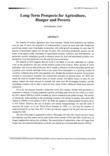Long-Term Prospects for Agriculture, Hunger and Poverty
JIRCAS international symposium series
| ISSN | 13406108 |
|---|---|
| 書誌レコードID(総合目録DB) | AA1100908X |

本文フルテキスト
intlsymp-12_43-54.pdf2.25 MB
The benefits of modern agriculture have been immense. Global food production has doubled over the past 30 years, the proportion of undernourished is down by more than half. Production growth has mainly come from higher productivity, with yield growth accounting for more than 70 percent of incremental output over the past 30 years. The astounding productivity growth was the result of far-sighted public investment in agricultural research, extension, and intensification. As production growth outstripped growth in demand, prices for food and agricultural products have declined by more than 60 percent over the past 40 years in real terms.
The outlook to 2030 suggests that the world is not likely to run into constraints on a global scale on the production side that would threaten global food security. While growth of world agriculture will be lower than in the past, this is mainly a reflection of lower population growth and a gradual move towards mid-high levels of per capita food consumption in a growing number of countries, including some of the most populous ones. Despite the slowdown in growth, the projected increase in consumption translates into considerable increases in absolute terms. By 2030, this means the need for another billion tonnes of cereals, another 160 million tonnes of meat, etc. per annum. Almost the entire increase in demand will come from the developing countries, and the developing countries will be able to meet the lion's share of their additional needs from domestic production.
All in all, the progress towards a better-fed world will continue. Global food production is expected to continue to outstrip population growth, providing more food for the world as a whole. By 2015, almost 3000 kcal will be available per person measured at the global average. The number of chronically undernourished in the developing countries will decline in tandem, from about 800 million in 1999/01 to 610 million in 2015. By 2030, the number of undernourished should be down to 443 million. However, the rate of decline will remain disappointingly low and fall short of meeting the target set at the World Food Summit in 1996, i.e., halving the number of undernourished by no later than 2015. In fact, the outlook suggests that. the goal will not even be reached by 2030.
The rest of this paper is organized as follows. This paper will start with a brief overview of past developments and then sketch out the main results of the outlook to 2015 and 2030. It will focus on hunger, malnutrition and poverty problems. The presentation of malnutrition issues will range from hunger and micronutrient deficiencies to obesity and related non-communicable diseases (NCDs).
The outlook to 2030 suggests that the world is not likely to run into constraints on a global scale on the production side that would threaten global food security. While growth of world agriculture will be lower than in the past, this is mainly a reflection of lower population growth and a gradual move towards mid-high levels of per capita food consumption in a growing number of countries, including some of the most populous ones. Despite the slowdown in growth, the projected increase in consumption translates into considerable increases in absolute terms. By 2030, this means the need for another billion tonnes of cereals, another 160 million tonnes of meat, etc. per annum. Almost the entire increase in demand will come from the developing countries, and the developing countries will be able to meet the lion's share of their additional needs from domestic production.
All in all, the progress towards a better-fed world will continue. Global food production is expected to continue to outstrip population growth, providing more food for the world as a whole. By 2015, almost 3000 kcal will be available per person measured at the global average. The number of chronically undernourished in the developing countries will decline in tandem, from about 800 million in 1999/01 to 610 million in 2015. By 2030, the number of undernourished should be down to 443 million. However, the rate of decline will remain disappointingly low and fall short of meeting the target set at the World Food Summit in 1996, i.e., halving the number of undernourished by no later than 2015. In fact, the outlook suggests that. the goal will not even be reached by 2030.
The rest of this paper is organized as follows. This paper will start with a brief overview of past developments and then sketch out the main results of the outlook to 2015 and 2030. It will focus on hunger, malnutrition and poverty problems. The presentation of malnutrition issues will range from hunger and micronutrient deficiencies to obesity and related non-communicable diseases (NCDs).
| 作成者 | Josef Schmidhuber |
|---|---|
| 公開者 | Japan International Research Center for Agricultural Sciences |
| オンライン掲載日 | |
| 号 | 12 |
| 開始ページ | 43 |
| 終了ページ | 54 |
| 言語 | eng |
